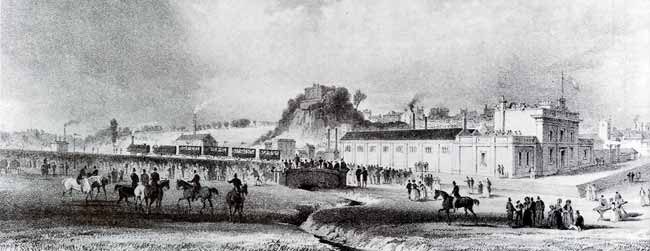< Previous | Contents | Next >
Carrington Street, Queen's Walk, Arkwright Street
The site of Collin's Alms Houses was called the Cherry Orchard right down to the beginning of last century. There is nothing of great interest in Carrington Street. Its importance is almost entirely due to its connection with the railways and to afford ready access to the station, in 1841, a bridge was thrown over the canal. Before that time the route to the station had been down Grey Friar Gate over the Navigation Bridge in Wilford Road and then sharply to the left down a street called Locomotive Street which has now disappeared and seems to be absorbed in the L.M. & S. Goods Yard. It is interesting to record that when Queen Adelaide visited Nottingham on her journey to Harewood the first part of her journey was taken by carriage and she took up the train at Nottingham. Her route through Nottingham was up what we now call London Road, along Leenside and then over the Navigation Bridge.
The original Carrington Street Bridge was designed by Mr. Moses Wood and was erected by Messrs. Court & Company whose foundry was at the corner of Granby Street and Friar Lane. It cost roughly £6,000 and of such importance was it to the railway company that the directors of the Midland Railway paid half the cost. After a series of vicissitudes it was finally widened and put into its present form in 1902.

Nottingham's first railway station opened in 1839.
The first railway to reach Nottingham was the Midland Railway and a branch from Nottingham to Derby was opened on May 30th, 1839, about six years before the Railway Mania. The first train, which carried directors and their friends only, started from Nottingham and the site of the original station is at present occupied by the Goods Offices. In fact I believe that this building incorporates the old station. Tremendous public interest was aroused by the new means of locomotion and soon after the railway started running a special excursion train proceeded from Nottingham to Derby. It surely must be a record in length, for it consisted of no less than eighty coaches, though the coaches of those days were very much smaller than those to which we are accustomed.
In 1846 the line was extended to Lincoln and consequently a level crossing was necessary for the passage of Carrington Street, and a new station was built in Station Street. This station is still well remembered and its main entrance was about opposite the end of Trent Street. It remained in use until 1904 when the present station was opened. The level crossing in Carrington Street was a terrible nuisance and in order to facilitate the passage of foot passengers a wooden up and down bridge was constructed which was so ugly that it called forth comment and satire on all hands. Eventually it was pulled down and a viaduct was erected over the crossing in 1866 from the designs of Mr. Tarbottom, the borough engineer who was also responsible as we have seen, for the erection of Trent Bridge. One gets a reflection of Railway management in an old account of an unfortunate railway accident which occurred between Nottingham and Beeston in 1844 during the prevalence of a fog by which three people lost their lives. This was looked upon as a terrible disaster and very minute inquiries were made as to the responsibility for its occurrence. In the light of our own days the evidence given at this inquiry is really most astonishing and the most extraordinary feature of it seems to be the indignation expressed by the witnesses that one train was proceeding at "the reckless speed of thirty miles per hour."
Queen's Walk is part of an ancient track or footway which led from Wilford Ferry to the town wharfs on the Leen and is the westward branch, which may be compared to the more easterly, Trent Bridge Footway, which led from the same point on the Leen down to Trent Bridge. It was formed into a promenade road in 1855, but it was soon found to be very subject to floods and so in 1862 it was raised above flood level. It remained a pleasant footway bordered with trees until 1926 when the exigencies of modern traffic have made it necessary to form it into a thoroughfare capable of bearing heavy traffic. It is well worth noticing that from about half way down it there is a very beautiful view of St. Mary's Church and the acropolis of ancient Nottingham.
Arkwright Street is quite a modern thoroughfare, formed after the enclosures of the Meadows about 1865 in which work Mr. Patchitt was so much concerned. At first it was called Trent Bridge Road, but the more modern name commemorating one of Nottingham's greatest celebrities is much more suitable. Being so modern there is little of interest in it. St. Saviour's Church takes the place of an old Mission Chapel which was built in 1869, otherwise there is nothing of antiquarian interest to mention in its whole route. It has drawn by far the greater part of the traffic away from the old London Road and is one of the busiest and most important thoroughfares in modern Nottingham.
